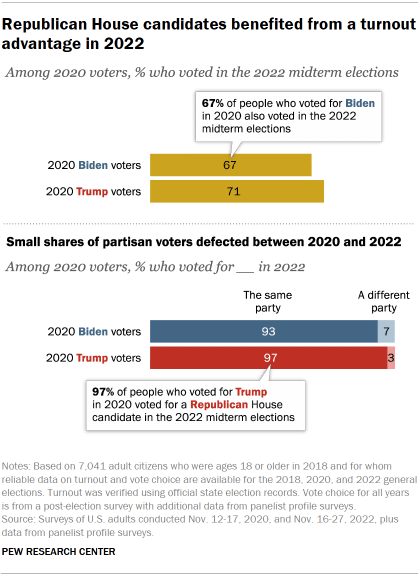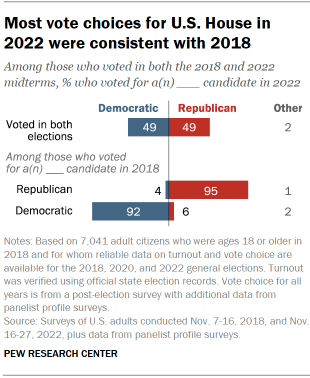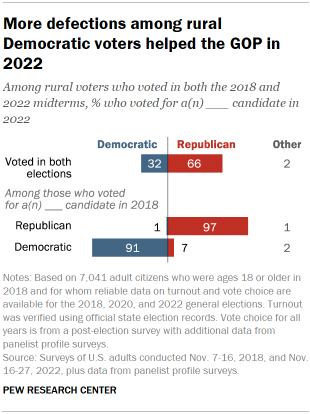An examination of the 2022 elections, based on validated voters
BY HANNAH HARTIG, ANDREW DANILLER, SCOTT KEETER AND TED VAN GREEN

We conducted this study to better understand which voters cast ballots in the 2022 midterm elections and how they voted. We also wanted to compare how turnout and vote choices differed from previous elections in 2020, 2018 and 2016. Measuring turnout among different groups in the electorate is challenging; it is particularly difficult to assess changes in turnout from election to election.
Panel data provides us a unique opportunity to study elections. By surveying the same people over time, we can more clearly see how differences in who stays home – and who turns out to vote –impacts each election. We can also measure how adults’ partisan voting preferences change (or do not change) between elections
For this study, we surveyed U.S. adults online on our nationally representative American Trends Panel (ATP). We verified their turnout in the four general elections using commercial voter files that aggregate publicly available official state turnout records. Panelists who said they voted and for whom a voting record was located are considered validated voters; all others are presumed not to have voted.
Additionally, we revised our statistical approach for the 2020 survey. That produced new results that slightly changed the numbers we reported about the 2020 election but changed no substantive findings in our report.
Here are the questions used for this report, along with responses, and its methodology.
American Trends Panel: Pew Research Center’s online probability survey panel, which consists of more than 12,000 adults who take two to three surveys each month. Some panelists have been participating in surveys since 2014.
Defectors/Defection: People who either switch their vote to a different party’s candidate from one election to the next, or those who in a given election do not support the candidate of the party they usually support. Also referred to as “vote switching.”
Drop off/Drop-off voters: People who vote in a given election but not in a subsequent election. The term commonly refers to people who vote in a presidential election but not in the next midterm. It can also apply to any set of elections.
Midterm elections: General elections held in all states and the District of Columbia in the even-numbered years between presidential elections. All U.S. House seats are up for election every two years, as are a third of U.S. Senate seats (senators serve six-year terms).
Mobilize: Efforts by candidates, political campaigns and other organizations to encourage or facilitate eligible citizens to turn out to vote.
Nonvoter: Citizens who didn’t have a record of voting in any voter file or told us they didn’t vote.
Panel survey: A type of survey that relies on a group of people who have agreed to participate in multiple surveys over a time period. Panel surveys make it possible to observe how individuals change over time because the answers they give to questions in a current survey can be compared with their answers from a previous survey.
Party affiliation/Party identification: Psychological attachment to a particular political party, either thinking of oneself as a member of the party or expressing greater closeness to one party than another. Our study categorizes adults as Democrats or Republicans using their self-reported party identification in a survey.
Split-ticket voting/Straight-ticket voting: Voters typically cast ballots for more than one office in a general election. People who vote only for candidates of the same party are “straight-ticket” voters, while those who vote for candidates of different parties are “split-ticket” voters.
Turnout: Refers to “turning out” to vote, or simply “voting.” Also used to refer to the share of eligible adults who voted in a given election (e.g., “The turnout in 2020 among the voting eligible population in the U.S. was 67%”).
Validated voters/Verified voter: Citizens who told us in a post-election survey that they voted in the 2022 general elections and have a record for voting in a commercial voter file. (The two terms are interchangeable).
Voter file: A list of adults that includes information such as whether a person is registered to vote, which elections they have voted in, whether they voted in person or by mail, and additional data. Voter files do not say who a voter cast a ballot for. Federal law requires states to maintain electronic voter files, and businesses assemble these files to create a nationwide list of adults along with their voter information.

In midterm elections that yielded mixed results for both parties, Republicans won the popular vote for the U.S. House of Representatives largely on the strength of higher turnout.
A new Pew Research Center analysis of verified voters and nonvoters in 2022, 2020, 2018 and 2016 finds that partisan differences in turnout – rather than vote switching between parties – account for most of the Republican gains in voting for the House last year.
Overall, 68% of those who voted in the 2020 presidential election turned out to vote in the 2022 midterms. Former President Donald Trump’s voters turned out at a higher rate in 2022 (71%) than did President Joe Biden’s voters (67%).
For additional analysis of voter turnout in the 2022 election, refer to Chapter 1 of this report.
Large majority of voters stuck with 2020, 2018 party preference in their 2022 vote choices
As in previous elections, party loyalty remained strong in last fall’s midterms.
Relatively small shares of voters defected from their partisan affiliation or 2020 presidential vote. Among those who voted for both president in 2020 and for a House representative in 2022, just 6% crossed party lines between elections or voted for third-party candidates in either election.
Similarly, the vast majority of those who voted in both 2018 and 2022 had consistent party preferences across the two elections: 95% of those who voted for a Republican candidate in 2018, and 92% of those who voted for a Democrat, voted for a House candidate of the same party four years later.
Democratic 2018 voters were slightly more likely than Republican 2018 voters to defect in 2022, with the net consequences of the party balance flipping 1 or 2 percentage points to the GOP.
That is a potentially impactful shift in an environment of very close elections, but the greater driver of the GOP’s performance in 2022 was differential turnout: higher turnout among those supporting Republican candidates than those supporting Democratic candidates.

Given sharp political divisions in the United States, small changes in voter turnout from election to election have big consequences. Political polarization has meant that most people who vote in midterm elections are committed politically, making it unlikely they would defect from their partisan affiliation.
Shifts in turnout, as opposed to defections, were responsible for most of the changes in vote margins from the 2018 midterms within most subgroups in the population. For example, the Democratic advantage among women dropped from 18 points in 2018 (58% Democratic, 40% Republican) to just 3 points in 2022 (51% and 48%, respectively).
But when looking only at women who voted in both elections, there is no net advantage for either party from defections: 6% of those who voted Democratic in 2018 flipped to vote for a Republican candidate in 2022, and a nearly identical share of women who voted Republican in 2018 voted for a Democratic candidate in 2022 (5%).

Virtually all of the decline in the Democratic advantage among women is explained by the fact that the 2022 turnout rate for women who voted Republican in 2018 was 8 points higher than the rate for women who voted Democratic that year (84% vs. 76%).
There were a few important exceptions to this general rule.
For example, more rural voters changed their vote from a Democratic to a Republican candidate between 2018 and 2022 than the reverse. The Republican margin among this group nearly doubled between 2018 and 2022 (from 21 points to 40 points). Among rural voters, Republican candidates in 2022 held on to 97% of those who voted Republican in 2018, while Democratic candidates held on to a smaller share (91%).
And among White voters with no college degree, Republicans benefited from slightly higher rates of defection from Democratic candidates among those who voted in both elections
Chapter 2 of this report features detailed breakdowns of voting patterns across the electorate.
‘Drop-off’ voters contributed to Republican House gains
Collectively, Republican candidates for the House received roughly 51% of the total vote last fall compared with 48% for Democratic candidates. This helped the Republican Party gain a narrow majority in the House. Democrats retained control of the Senate. While Republicans exceeded expectations in a few states – notably New York and Florida – pre-election predictions of a “red wave” failed to materialize.
However, the broad outcome of the elections in much of the country was shaped largely by the underlying political makeup of the 2022 voters and how they differed from the voters of 2020 and 2018.
Midterm voters tend to be older, more educated and more affluent than those who vote just in presidential election years, a pattern apparent in both 2018 and 2022. The two elections also had something else in common: The president’s party suffered more “drop-off” voters than did the opposing party.
People who voted in 2018 who did not turn out in 2022 (“drop-off” voters), had favored Democrats in 2018 by about two-to-one (64% to 33%). Likewise, about a third of 2020 voters (32%) did not turn out in 2022. This group voted 53% to 43% for Joe Biden. The absence of these 2020 Biden voters resulted in a worse performance for Democratic candidates in 2022.
The drop-off voters mattered but so, too, did voters who turned out in 2022 but not in earlier elections – and these voters also helped Republican candidates. Those voting in 2022 included 21% who had not voted in 2018. This group supported Republican candidates in 2022 by a margin of 58% to 40%.
National polling data, especially when based on interviews conducted over time with the same individuals, can shed light on these dynamics. But there are limitations with national data, given that midterms are state and local elections. Partisan defections and split-ticket voting were critically important to the success of individual candidates for U.S. Senate and governor. These defections tended to benefit Democratic candidates more often than Republican candidates, even when national turnout trends mostly benefited Republican candidates.
This study is based on surveys of members of the Center’s American Trends Panel following the last four general elections (2016-2022). Voter turnout in each election was verified by a comparison with official records.
Some of the analysis focuses on a subset of 7,041 panelists interviewed post-election in 2022 for whom reliable measures of voter turnout and candidate choice were also available for the 2018 and 2020 elections. This allowed us to analyze how individuals’ voting preferences changed over time, separating the political consequences of changes in party preferences from changes in who turned out in each election. (All analysis that considers individual-level changes in turnout or vote preference excludes the 2016 dataset, due to diminishing sample sizes among those who were in the panel across multiple elections.)
Other key findings from the study
- Voters under 30 continued to strongly support the Democratic Party, voting 68% to 31% for Democratic candidates. But this margin was somewhat narrower than in 2018. Republicans benefitted more from significant drop off in voter turnout among younger age groups between 2018 and 2022, since young voters tend to support Democrats. Voters under 30 accounted for 10% of the electorate in 2022 – similar to their share of all voters in 2018 (11%), but down from 2020 (14%). To learn more about voter demographics, such as age, race & ethnicity, religion and community type, refer to Chapter 3 of this report.
- Ideological polarization by party was nearly complete in 2022: Only 1% of self-described conservative Republicans voted for Democratic House candidates and less than 1% of liberal Democrats voted Republican.
- Voting in person on Election Day increased sharply in 2022 compared with 2020. More voters reported casting ballots in person on Election Day in both parties, but the share remained much higher among Republican voters (51%) than among Democratic voters (34%).
- White voters without college degrees made up a majority (54%) of Republican voters in 2022, compared with 27% of Democratic voters. Yet these voters made up a somewhat greater share of GOP voters in 2020 (58%) and 2018 (57%).
- Voters ages 50 and older were a larger share of the total in 2022 (64%) than in any of the past three elections. 70% of Republican voters were 50 or older, as were 57% of Democratic voters.
- Hispanic voters continued to support Democrats, but by a much smaller margin than in 2018: Hispanic voters favored Democratic candidates by a 21-point margin in 2022, compared with a 47-point margin in 2018. This change was driven by asymmetric changes in voter turnout among Hispanic adults, rather than changing preferences among individual Hispanic voters.
- Black voters continued to support Democrats by overwhelming margins: 93% voted for Democrats in the midterms while 5% supported Republicans. This is similar to levels of support in 2020, 2018 and 2016. Black voters made up 9% of the electorate in both 2022 and 2018 and 11% of the electorate in 2020.
- The Republican advantage among White evangelical Protestants was somewhat larger in 2022 than in the past three elections. 86% supported Republican candidates in 2022 and only 12% voted Democratic.


